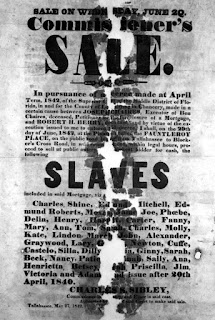Last
week, I was thankful for the
opportunity to do two presentations on my new book, The Weeping Time: Memory and the Largest Slave Auction in American History—one at Binghamton University and the other at a
conference at Columbia University. Several
people in attendance commented on the state of Black families. As such, I
thought I would share an excerpt from the book on the subject.
The Black Family and Its Resilience
The
auction and its aftermath also speak to contemporary perceptions of the Black
family by providing it with a historical context. Then and now, policymakers and many others
are wont to observe that the African American family is in a state of
crisis. Senator Daniel Moynihan’s famous
report on the Black family, “The Negro Family:
The Case for National Action,” did little to alleviate concerns about
the state of the black family in 1965[i]. He mistakenly blamed the black female “matriarch” for the breakdown while
others who wrote after him placed the blame more squarely on the institution of
slavery and its subsequent legacy of racial discrimination and exclusion. As Congress of
Racial Equality ( CORE) activist and psychologist William Ryan said in reaction
in an article in The Nation, “ The problem is discrimination;” we ought not, then, “to blame the victim.”[ii] Or, as historian
Pennigroth in Stephanie Camp’s groundbreaking New Studies in Slavery, says eloquently: “rather than a source of
continuing dysfunction, proponents of this view argue, that the Black family,
the Black community and Black traditions of property ownership have been the
only things keeping Black people from
total annihilation.”[iii] This book affirms the view that the Black
family is a resilient institution.
The
statistics of the second decade of the twenty first century are no better than
those from 1965 and, according to the Urban Institute’s 50th
anniversary report on the Moynihan Report, they are in fact by some indicators worse, and not just
for Black families. Even with a Black family in the White House from
2008-2016, and a much larger middle class, little can be said to have
changed for a persistent underclass. Sociologist
William Julius Wilson points the finger at the loss of manufacturing jobs, “the
surburbanization” of employment and structural racism. It is the high rate of joblessness, he
asserts, that leads to crime and other negative impacts on black family life
and communities.[iv] The
Urban Institute additionally identifies disparities in education and the need
for reform of the criminal justice system as major contributing factors
particularly with respect to black men.
With
the ongoing talk about “dysfunction” stemming from the breakdown of the Black
family, it is perhaps not surprising that some Black students in my classes on
slavery often try to draw a straight line from slavery to modern times when attempting to make sense of
the Black family. “Is this why the Black family is in the state that it is in today?” they often ask
and try to answer as they devour historical texts. I continually have to remind them that there
is not, and has never been, a straight
line that can be drawn between slavery and contemporary times.
In
fact, what this account of the Weeping Time may tell us if nothing else is just
how Black families struggled to stay together in spite of the odds during and after the time of slavery. The auction
itself reminds us of the structural attacks with which Black families have had
to contend throughout American history, the series of disruptions they have
endured from Africa to America’s shores, and then again and again as slave were
sold to different locations across the country.
So while the line may not be straight, there is definitely continuity of
the themes of struggle and resilience.
The Weeping Time
strives to show just how critical it was for these families to restore the
breach after Emancipation and the importance of family ties – more than money, jobs and education. Many of these newly freed slaves set out on
foot flocking to plantations all over the South searching earnestly for their
loved ones. They took with them a lock
of hair, a swath of clothing – small mementos that they had saved prior to the
auction sales. They pursued every avenue in search of those whom they had
lost. They found their way to African
American churches and other gathering places looking for their loved ones. They
searched from town to town, and in some cases, from state to state, attempting
to reassemble the broken fragments that the auction, among other experiences in
slavery, had brought about.[v] So
the story of the Weeping time is not just about the breach caused by the auction
itself, but about the restoring of kinship ties in spite of the odds. It is a story of resilience, or what I call “the gift of resilience.”[vi]
Anne C. Bailey
Author of The Weeping Time: Memory and the Largest Slave Auction in American History. (Cambridge University Press, 2017)
Author of The Weeping Time: Memory and the Largest Slave Auction in American History. (Cambridge University Press, 2017)
[i] Daniel
Patrick Moynihan, “The Negro Family: The Case for National Action,” 1965.
[ii] http://www.city-journal.org/html/15_3_black_family.html
[iii]
Edward Baptist and Stephanie Camp, New
Studies in the History of American Slavery, (Athens, Georgia: University of
Georgia Press, 2006), 173.
[iv] Gregory Acs, Kenneth Braswell, Elaine Sorensen, Moynihan Report Revisited (Washington, DC: Urban Institute, June 13, 2013); By some indicators, such as college attendance, there has been substantial improvement. William Julius Wilson, Truly
Disadvantaged, (Chicago: University of Chicago Press, 1987) 17.
[v]
Herbert Gutman, The Black Family in
Slavery and In Freedom 1750-1925, (New York:Vintage Press, 1976)
[vi]
See more in the last chapter on Memory.
Presentation at Binghamton University, December 6, 2017.
Reminder: Anne Bailey
on the Travel Channel this coming Thursday, December 21 at 9pm.
****PLEASE ADD YOUR EMAIL at the lower right corner for new articles every weekend.










